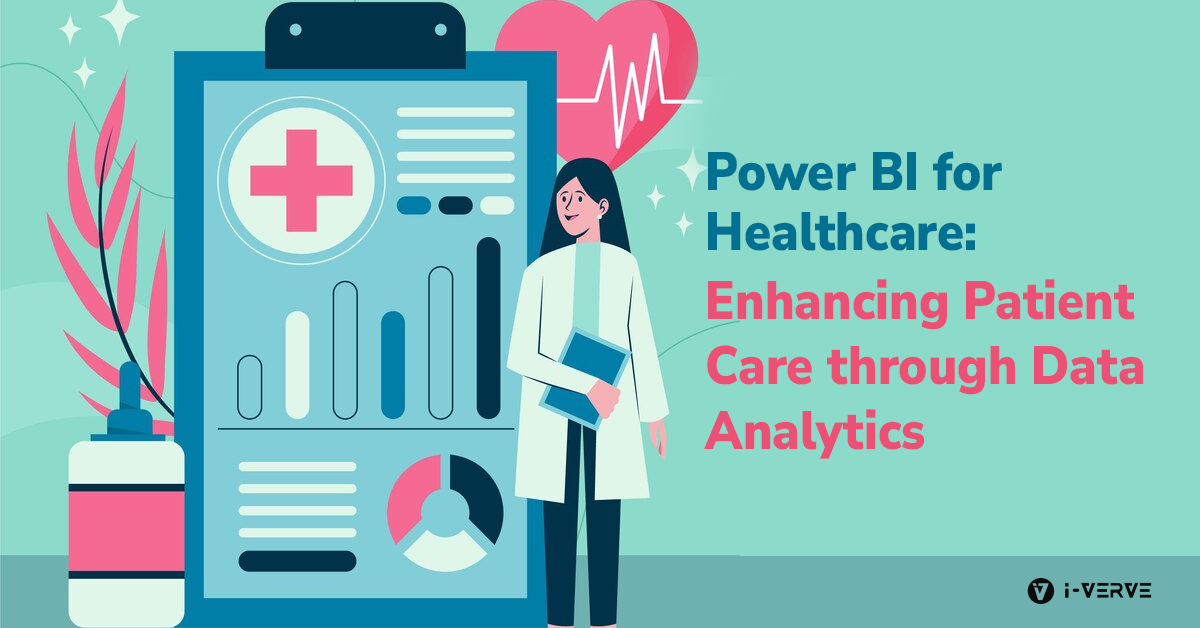Introduction
In the ever-evolving landscape of healthcare, the role of data analytics has become increasingly crucial. This blog explores the transformative potential of Power BI, Microsoft’s business intelligence tool, in revolutionizing healthcare data analytics. The objectives include understanding Power BI’s analytical capabilities, its significance in data-driven decision-making, and its impact on patient care.
The Role of Data Analytics in Healthcare
Data analytics is pivotal in modern Healthcare, driving informed decision-making, improving patient outcomes, and enhancing operational efficiency. The integration of advanced analytics tools, such as Power BI, holds the potential to revolutionize how healthcare organizations leverage data. These tools transform raw data into actionable insights, offering a comprehensive approach to improving healthcare management and ultimately enhancing the quality of patient care.
Objectives of the Blog
– Provide an overview of Power BI in the context of healthcare analytics.
– Explore its applications in patient data management, clinical decision support, and improving patient outcomes.
– Discuss the monitoring and reporting of healthcare KPIs using customized dashboards.
– Address the importance of data security, compliance with healthcare regulations, and integration with Electronic Health Records (EHR).
– Outline steps to implement Power BI in healthcare settings, common challenges, and future trends in healthcare analytics.
Overview of Power BI in Healthcare
Power BI’s Analytical Capabilities
There are lots of benefits of Power BI. It offers robust analytical capabilities, allowing healthcare professionals to visualize and analyze complex datasets. Its interactive dashboards and reports provide a comprehensive view of critical metrics, facilitating data-driven decision-making.
Significance of Data-Driven Decision-Making
Data-driven decision-making is essential in Healthcare for optimizing processes, resource allocation, and treatment plans. Power BI empowers healthcare providers to make informed decisions by transforming raw data into actionable insights.
Patient Data Management and Analysis
Centralizing Patient Information
Power BI streamlines Healthcare by centralizing patient information from diverse sources, creating a unified view. This approach enhances data accessibility for healthcare professionals, promoting more efficient and coordinated care. The centralized patient information system contributes to improved decision-making, ultimately benefiting both healthcare providers and patients.
Real-Time Monitoring of Patient Health
Power BI’s real-time monitoring capabilities enable healthcare providers to track patient health data continuously. It allows for early detection of trends or abnormalities, leading to timely interventions and personalized patient care.
Enhancing Clinical Decision Support
Integration of Power BI into Clinical Decision Support Systems
Integrating Power BI into Clinical Decision Support Systems (CDSS) enhances the decision-making process for healthcare professionals. By providing visual representations of medical data, It aids in diagnosing conditions, choosing treatment plans, and improving overall clinical outcomes.
Power BI’s seamless integration with CDSS ensures that clinicians have access to real-time, comprehensive insights, empowering them to make informed decisions at critical junctures in patient care.
Visualizing Medical Data for Clinicians
Power BI’s visualization tools transform complex medical data into easy-to-understand visuals. Clinicians can analyze trends, identify patterns, and make informed decisions based on visually represented patient data, fostering a more intuitive approach to Healthcare.
The platform’s interactive dashboards and reports provide a dynamic environment for clinicians to explore and interpret data. This visualization capability not only enhances the diagnostic process but also contributes to more effective communication among healthcare teams.
Improving Patient Outcomes
Utilizing Predictive Analytics for Proactive Care
Power BI’s predictive analytics capabilities enable healthcare providers to anticipate patient needs and intervene proactively. By analyzing historical data, identifying patterns, and utilizing machine learning algorithms, Power BI helps in predicting potential health risks and complications.
This proactive approach allows healthcare professionals to implement preventive measures, personalized care plans, and targeted interventions. Predictive analytics powered by Power BI contributes significantly to improving patient outcomes by minimizing risks and ensuring timely, targeted healthcare interventions.
Monitoring and Reporting on Healthcare KPIs
Defining Key Performance Indicators (KPIs) in healthcare
Defining and monitoring Key Performance Indicators (KPIs) is vital for assessing healthcare performance. Power BI allows organizations to customize KPIs based on specific goals, providing a comprehensive overview of performance metrics.
Customized Dashboards for KPI Tracking
Power BI’s dashboard customization features allow healthcare organizations to create tailored dashboards for tracking KPIs. These visually engaging dashboards offer real-time insights, fostering data-driven decision-making at every level of healthcare management.
Customized dashboards can include KPIs related to patient satisfaction, operational efficiency, resource utilization, and clinical outcomes. The ability to visualize these metrics in real-time enhances transparency and accountability within healthcare organizations.
Ensuring Data Security and Compliance
Importance of Data Security in Healthcare
Data security is supreme in healthcare to protect delicate patient information. Power BI adheres to stringent security measures, including encryption and access controls, ensuring that healthcare data remains confidential and secure.
Compliance with Healthcare Regulations
Power BI supports healthcare organizations in meeting regulatory requirements. By adhering to healthcare data protection regulations, Power BI ensures that organizations maintain compliance and avoid legal implications.
Integration with Electronic Health Records (EHR)
Seamless Integration with EHR Systems
Power BI seamlessly integrates with Electronic Health Records (EHR) systems, providing a unified platform for accessing and analyzing patient data. This integration enhances the efficiency of healthcare workflows and improves the overall quality of patient care.
Enhancing EHR Data Visualization
Power BI enhances the visualization of EHR data, making it more accessible and interpretable for healthcare professionals. The platform’s interactive features enable clinicians to explore patient histories, treatment plans, and outcomes in a visually intuitive manner.
The integration with EHR systems ensures that healthcare professionals have a holistic view of a patient’s medical history, treatment plans, and outcomes in one centralized location. This streamlined access to EHR data contributes to more informed decision-making and continuity of care.
Steps to Implement Power BI in Healthcare
Assessing Healthcare Analytics Needs
Before implementing Power BI, healthcare organizations must assess their analytics needs. Identifying specific goals, data sources, and desired outcomes helps in tailoring Power BI applications to meet the unique requirements of the organization.
Implementing Power BI in Healthcare Settings
Power BI’s integration in healthcare requires configuring the platform to assess needs. It involves defining data sources, creating dashboards, and collaborating among IT teams, data analysts, and healthcare professionals to align with strategic objectives and enhance analytics capabilities.
Challenges and Solutions
Common Challenges in Healthcare Analytics
Implementing healthcare analytics using Power BI may face challenges such as data silos, resistance to technology adoption, and ensuring data accuracy. Addressing these challenges requires a combination of data integration strategies, change management, and data quality assurance measures.
Solutions and Best Practices
To overcome challenges, healthcare organizations should prioritize data integration, establish a culture of technological adoption through comprehensive training programs, and implement data validation processes to ensure accuracy and reliability.
Data integration strategies involve breaking down silos between different departments and systems within healthcare organizations. It ensures that relevant data is accessible across the organization, fostering a more holistic approach to healthcare analytics.
Change management is critical to overcoming resistance to technology adoption. Healthcare professionals should be involved in the decision-making process, and training programs should be designed to familiarize them with Power BI’s capabilities and benefits.
Data validation processes involve regular audits and checks to ensure the accuracy and reliability of data within the Power BI platform. It confirms that the insights derived from Power BI are trustworthy and can be relied upon for informed decision-making.
Future Trends in Healthcare Analytics
Evolving Technologies in Healthcare
The future of healthcare analytics involves integrating evolving technologies like artificial intelligence (AI), machine learning (ML), and the Internet of Things (IoT). Power BI leverages these advancements, enabling predictive analytics, personalized medicine, and enhanced patient care. AI and ML enhance predictive analytics, improving patient outcome predictions, identifying trends, and supporting clinical decision-making. The IoT contributes to real-time patient data collection from wearables and connected health technologies. Power BI processes and visualizes this data, providing comprehensive, real-time insights into patient health. The implementation of Power BI development services further solidifies its role as a vital tool in the evolving landscape of healthcare analytics.
Preparing for Advanced Healthcare Analytics
Healthcare organizations need to prepare for advanced analytics by investing in technologies that complement Power BI. Embracing a culture of continuous learning, staying updated on industry trends, and fostering partnerships with tech innovators are crucial for staying ahead in the rapidly evolving landscape of healthcare analytics.
Fostering partnerships with tech innovators and solution providers ensures that healthcare organizations have access to the latest tools and technologies. Collaborating with experts in the field can provide valuable insights and support in implementing advanced healthcare analytics solutions.
Conclusion
In conclusion, the implementation of Power BI development services emerges as a transformative tool in healthcare, revolutionizing patient care through data analytics. From centralizing patient information to enhancing clinical decision support, Power BI offers a comprehensive solution for healthcare analytics needs. The integration with EHR systems, customization of dashboards for KPI tracking, and a focus on data security underscore the significance of Power BI’s role in Modern Healthcare.




